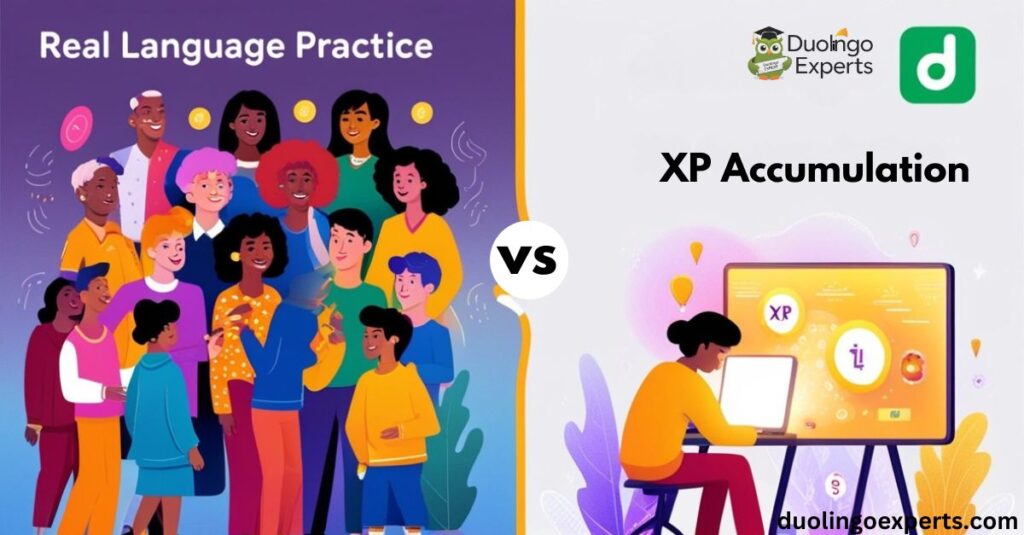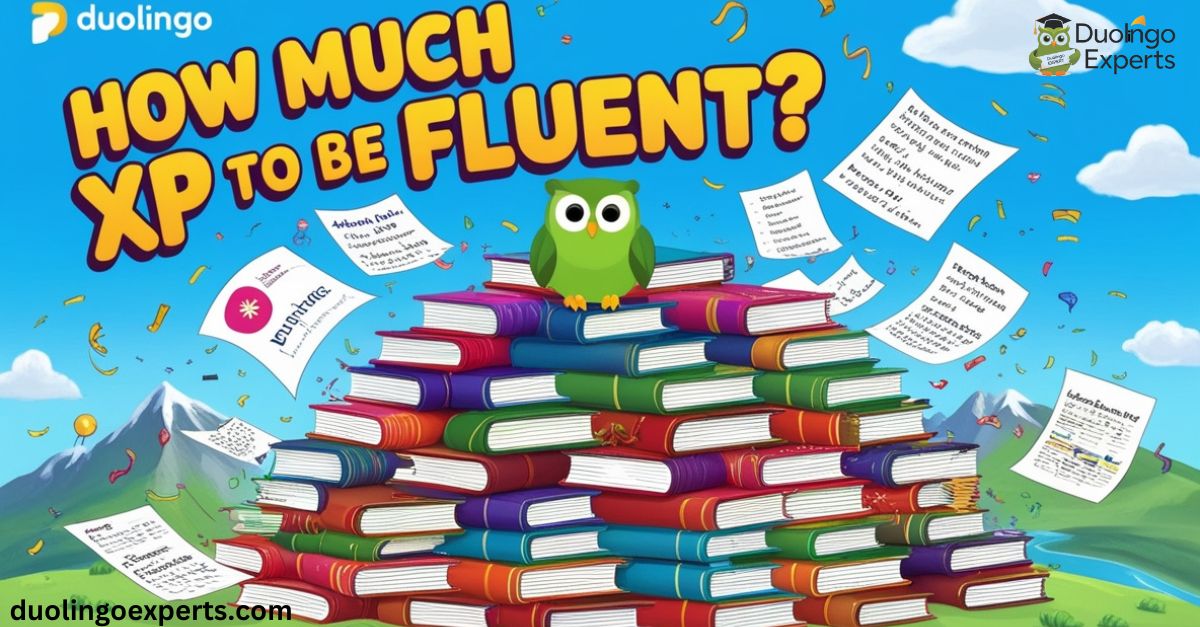Duolingo has revolutionized the way we approach language learning. It’s engaging, user-friendly, and has millions of learners around the globe. But there’s one question that many people ask: How much XP on Duolingo do you need to be fluent?
In this comprehensive guide, we’ll break down the Duolingo XP system, explore language proficiency benchmarks, and provide real insights into how much Duolingo XP truly correlates with language fluency. Along the way, we’ll debunk common myths and highlight the actual milestones that can help you reach fluency on Duolingo.
The Reality Behind Duolingo XP and Language Fluency
First, let’s get one thing straight: Duolingo XP is a fantastic metric for tracking your learning progress on the platform, but it doesn’t directly equal language fluency. While XP milestones help keep you motivated and engaged, they only represent a small part of the language learning process.
True language fluency involves much more than just accumulating points. It includes the ability to converse naturally, understand various accents, write clearly, and engage with native speakers in different contexts. Duolingo XP, however, primarily measures the number of lessons you’ve completed and how consistently you’ve practiced.
Duolingo Levels and Language Proficiency

Duolingo’s system tracks your progress through various Duolingo levels, each one reflecting how much you’ve learned. But how does this relate to actual language proficiency? Here’s a breakdown:
- Beginner Level: At this stage, you’re just starting to understand the basics. This is where you’ll learn simple phrases, greetings, and essential vocabulary.
- Intermediate Level: At this point, you’ve acquired enough vocabulary to hold conversations, understand basic grammar, and respond to simple questions.
- Advanced Level: Once you reach this level, you’ll be able to engage in more complex conversations, express opinions, and comprehend much more challenging material.
Each of these levels corresponds to a range of XP milestones, but it’s important to note that they do not always align perfectly with established language proficiency benchmarks like those defined by the Common European Framework of Reference for Languages (CEFR).
How Much XP on Duolingo to Be Fluent: Raw Numbers and Facts
Let’s get into the specifics. How much XP on Duolingo is actually required to reach fluency?
- Basic Conversation Skills XP Range: Around 1,000 – 5,000 XP. At this stage, you’ll have learned enough to handle basic greetings, introductions, and daily conversations.
- Intermediate Level XP Benchmarks: To reach an intermediate level (B1/B2 on the CEFR scale), you’ll need around 5,000 – 15,000 XP. You should be able to hold more nuanced conversations, understand simple texts, and express opinions in basic discussions.
- Advanced Proficiency XP Targets: To reach an advanced level (C1/C2 on the CEFR scale), you’ll need 20,000 – 30,000 XP or more. This will give you a solid grasp of grammar, vocabulary, and cultural nuances. You’ll be able to converse fluently and understand more complex content, including native-level media like films or podcasts.
Is 30,000 XP Enough for Fluency?
Reaching 30,000 XP is a major milestone, but it still doesn’t guarantee fluency. Fluency is more about how you apply what you’ve learned in real-life scenarios. For example, being able to hold a conversation with a native speaker, understand the humor in a TV show, or write an essay without making major mistakes are indicators of true fluency.
Daily XP Goals That Drive Real Progress

One of the best ways to stay on track with Duolingo language learning is by setting daily XP goals. Here are a few suggestions based on your personal goals:
- Beginner Learners: Aim for 10-20 XP per day. This is enough to build momentum without overwhelming yourself.
- Intermediate Learners: Aim for 20-50 XP per day. At this stage, you’ll need to practice more regularly to deepen your understanding of grammar and sentence structure.
- Advanced Learners: Aim for 50-100 XP per day. This will help you refine your skills and push through the more complex aspects of the language.
The Importance of Consistency
It’s better to practice consistently than to overdo it in one session and burn out. Duolingo’s Streak System rewards consistent daily practice, and this consistency can significantly boost your language proficiency over time.
XP Milestones and Language Proficiency
Understanding how Duolingo’s XP milestones correspond to proficiency levels can help you set realistic expectations. Here’s a guide to how much XP you’ll need to reach different CEFR levels:
| CEFR Level | XP Range | Language Ability |
|---|---|---|
| A1 | 1,000 – 3,000 XP | Can understand and use familiar everyday expressions. |
| A2 | 3,000 – 5,000 XP | Can communicate in simple and routine tasks. |
| B1 | 5,000 – 10,000 XP | Can deal with most situations that arise whilst traveling in the language area. |
| B2 | 10,000 – 15,000 XP | Can produce detailed text on a variety of subjects. |
| C1 | 15,000 – 25,000 XP | Can produce clear, well-structured, and detailed text. |
| C2 | 25,000+ XP | Can express themselves spontaneously, very fluently, and precisely. |
This table offers a rough guide, but remember, language fluency involves more than just XP. In fact, real language practice (speaking, listening, reading, and writing in real-world situations) is crucial for achieving full proficiency.
Common XP Myths Debunked
Let’s address some of the most common misconceptions about Duolingo and XP:
Myth 1: More XP = More Fluency
While XP is a measure of progress, fluency is about application. Simply reaching a high XP doesn’t mean you’ll be able to converse naturally in the language. It’s how you practice that matters.
Myth 2: Reaching the “Highest XP” Means You’re Fluent
A high XP level is impressive, but fluency isn’t just about vocabulary or grammar knowledge. It’s about how well you can communicate in the language, including cultural nuances and context.
Myth 3: Aiming for High XP Daily Guarantees Fast Fluency
Fluency is a gradual process, and high XP isn’t an automatic indicator of language mastery. You can hit high XP numbers without mastering listening comprehension or nuanced communication.
Skills Beyond XP Points
Duolingo XP focuses on vocabulary acquisition and grammar, but there are other skills you’ll need to develop to become truly fluent:
- Speaking Practice: Duolingo helps with sentence formation and grammar, but nothing beats real-time practice with native speakers. Tools like language exchange programs or language exchange apps can complement Duolingo and help you improve speaking fluency.
- Listening Comprehension: The ability to understand spoken language is crucial. Listening to podcasts, watching movies, and speaking with native speakers are essential for improving active listening skills.
- Cultural Understanding: Fluency goes beyond words. Understanding the cultural nuances of a language is just as important as learning its vocabulary and grammar.
Real Language Practice vs XP Accumulation

While XP accumulation can keep you motivated, it doesn’t provide the real-world practice that leads to fluency. Real language practice (speaking, writing, reading, and listening in everyday situations) is where the true progress happens.
Here are a few ways to practice:
- Language Exchange Programs: Partner with native speakers to practice real conversations.
- Language Meetups: Attend in-person or online meetups for conversation practice.
- Media Consumption: Immerse yourself in the language through movies, TV shows, and podcasts to improve listening comprehension.
Fluency Indicators Beyond XP
You can’t rely solely on Duolingo XP to assess your fluency. Here are some real indicators to look out for:
Conversation Readiness
- Can you hold a conversation for at least 10 minutes without major difficulty?
- Are you able to understand a wide range of topics, even if they are not directly related to your studies?
Reading Comprehension
- Can you read and understand books, articles, or even social media posts in your target language?
- Do you grasp the context, tone, and subtleties of the language?
Time Investment vs Language Progress
Time investment and XP tracking go hand in hand. But how much time should you spend each day on Duolingo to make tangible progress?
- Beginner Learners: 15-30 minutes a day will help you master the basics without feeling overwhelmed.
- Intermediate Learners: 30-45 minutes daily can push you into more complex language areas.
- Advanced Learners: An hour or more each day can help you reach near-fluency.
The more time you invest in Duolingo language learning, the faster your language proficiency will grow.
Frequently Asked Questions About Duolingo levels xp
What is Duolingo XP and how does it relate to language fluency?
Duolingo XP is a measure of how much you’ve learned on the platform, but it doesn’t directly correlate to fluency. Fluency depends on your ability to communicate naturally and understand nuances in the language.
How effective is Duolingo compared to traditional language learning methods?
Duolingo offers a flexible, gamified learning experience that’s more engaging than traditional classroom methods. However, it should be complemented with real-world practice.
What do Duolingo’s level system and XP requirements indicate about language proficiency?
Duolingo’s XP system reflects your progress through the app, but language proficiency involves real-life communication, which goes beyond points and levels.
How much XP do I need on Duolingo to be fluent?
To reach fluency, you’ll need around 20,000 – 30,000 XP or more, but real-world practice is essential.
How important is real-world language practice compared to accumulating Duolingo XP?
Real-world language practice is critical to achieving true fluency. While XP helps, speaking with native speakers, listening to authentic media, and writing in the language all contribute to mastery.
Who has the highest xp in Duolingo?
As of 2025, the highest XP in Duolingo is held by a user with over 700,000 XP. This impressive feat demonstrates their dedication to daily practice and language learning over an extended period.
Who has the most xp in Duolingo?
The user with the most XP in Duolingo has accumulated over 1.1 million XP. This achievement reflects years of consistent learning and dedication to mastering multiple languages.
How much xp in duolingo to be Fluent?
To reach fluency in Duolingo, you typically need between 20,000 to 30,000 XP, depending on the language. However, fluency also requires real-world practice, beyond just accumulating XP points.
How much XP is good in Duolingo?
Aiming for 50 to 100 XP per day is a good target in Duolingo for consistent progress. This ensures you’re reinforcing your skills while maintaining a steady learning pace.
Is B2 considered fluent?
Yes, a B2 level on the CEFR scale is considered an advanced intermediate level, where you can communicate effectively in most situations. It’s often seen as the threshold for being fluent in everyday conversations.
How long should I study Duolingo per day?
Studying 15 to 30 minutes per day on Duolingo is ideal for steady progress without burnout. Consistency is key, so make it part of your daily routine to maximize language learning.
Has anyone got fluent from Duolingo?
Yes, many users have reached fluency through Duolingo, especially when combined with real-world practice. The app provides a strong foundation, but fluency also requires speaking with native speakers and cultural immersion.
What is an ideal Duolingo score?
An ideal Duolingo score varies by individual goals, but aiming for 50-100 XP per day is a solid target for consistent progress. It’s more important to focus on steady learning rather than just high scores.
Conclusion
While Duolingo XP is an effective tool for tracking your progress, it’s not the sole indicator of language fluency. True fluency requires much more: real-world practice, understanding cultural contexts, and developing listening, speaking, and writing skills. Duolingo is a fantastic tool, but it should be supplemented with other methods, like language exchange programs and active listening.
Remember, language fluency is a gradual process. The key is consistency, realistic goals, and actively seeking out opportunities to practice in the real world.

DuolingoExperts, managed by MarkJohan, offers expert insights and tips for mastering languages. A tech-driven platform to enhance your learning experience.

